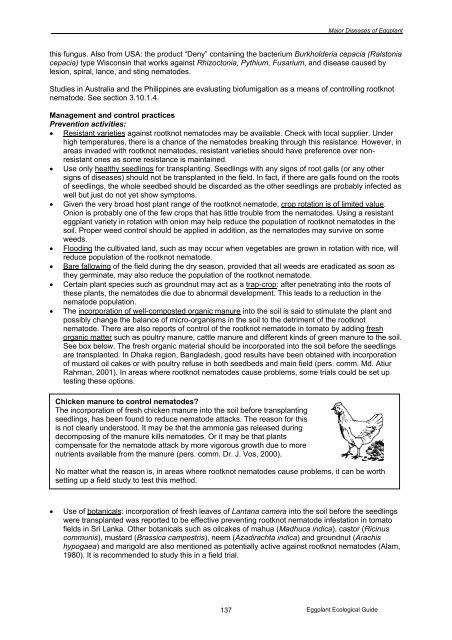Eggplant Integrated Pest Management AN ECOLOGICAL GUIDE
Eggplant Integrated Pest Management AN ECOLOGICAL GUIDE
Eggplant Integrated Pest Management AN ECOLOGICAL GUIDE
You also want an ePaper? Increase the reach of your titles
YUMPU automatically turns print PDFs into web optimized ePapers that Google loves.
__________________________________________________________________________________Major Diseases of <strong>Eggplant</strong>this fungus. Also from USA: the product “Deny” containing the bacterium Burkholderia cepacia (Ralstoniacepacia) type Wisconsin that works against Rhizoctonia, Pythium, Fusarium, and disease caused bylesion, spiral, lance, and sting nematodes.Studies in Australia and the Philippines are evaluating biofumigation as a means of controlling rootknotnematode. See section 3.10.1.4.<strong>Management</strong> and control practicesPrevention activities:• Resistant varieties against rootknot nematodes may be available. Check with local supplier. Underhigh temperatures, there is a chance of the nematodes breaking through this resistance. However, inareas invaded with rootknot nematodes, resistant varieties should have preference over nonresistantones as some resistance is maintained.• Use only healthy seedlings for transplanting. Seedlings with any signs of root galls (or any othersigns of diseases) should not be transplanted in the field. In fact, if there are galls found on the rootsof seedlings, the whole seedbed should be discarded as the other seedlings are probably infected aswell but just do not yet show symptoms.• Given the very broad host plant range of the rootknot nematode, crop rotation is of limited value.Onion is probably one of the few crops that has little trouble from the nematodes. Using a resistanteggplant variety in rotation with onion may help reduce the population of rootknot nematodes in thesoil. Proper weed control should be applied in addition, as the nematodes may survive on someweeds.• Flooding the cultivated land, such as may occur when vegetables are grown in rotation with rice, willreduce population of the rootknot nematode.• Bare fallowing of the field during the dry season, provided that all weeds are eradicated as soon asthey germinate, may also reduce the population of the rootknot nematode.• Certain plant species such as groundnut may act as a trap-crop: after penetrating into the roots ofthese plants, the nematodes die due to abnormal development. This leads to a reduction in thenematode population.• The incorporation of well-composted organic manure into the soil is said to stimulate the plant andpossibly change the balance of micro-organisms in the soil to the detriment of the rootknotnematode. There are also reports of control of the rootknot nematode in tomato by adding freshorganic matter such as poultry manure, cattle manure and different kinds of green manure to the soil.See box below. The fresh organic material should be incorporated into the soil before the seedlingsare transplanted. In Dhaka region, Bangladesh, good results have been obtained with incorporationof mustard oil cakes or with poultry refuse in both seedbeds and main field (pers. comm. Md. AtiurRahman, 2001). In areas where rootknot nematodes cause problems, some trials could be set uptesting these options.Chicken manure to control nematodes?The incorporation of fresh chicken manure into the soil before transplantingseedlings, has been found to reduce nematode attacks. The reason for thisis not clearly understood. It may be that the ammonia gas released duringdecomposing of the manure kills nematodes. Or it may be that plantscompensate for the nematode attack by more vigorous growth due to morenutrients available from the manure (pers. comm. Dr. J. Vos, 2000).No matter what the reason is, in areas where rootknot nematodes cause problems, it can be worthsetting up a field study to test this method.• Use of botanicals: incorporation of fresh leaves of Lantana camera into the soil before the seedlingswere transplanted was reported to be effective preventing rootknot nematode infestation in tomatofields in Sri Lanka. Other botanicals such as oilcakes of mahua (Madhuca indica), castor (Ricinuscommunis), mustard (Brassica campestris), neem (Azadirachta indica) and groundnut (Arachishypogaea) and marigold are also mentioned as potentially active against rootknot nematodes (Alam,1980). It is recommended to study this in a field trial.137<strong>Eggplant</strong> Ecological Guide




![Section 4 [ PDF file, 252 KB] - The Field Alliance](https://img.yumpu.com/51387260/1/158x260/section-4-pdf-file-252-kb-the-field-alliance.jpg?quality=85)











